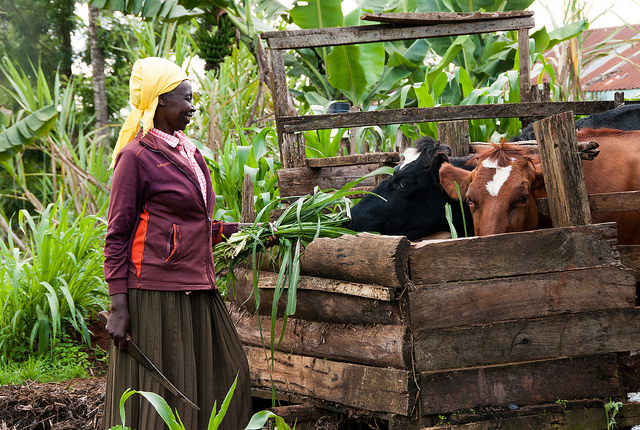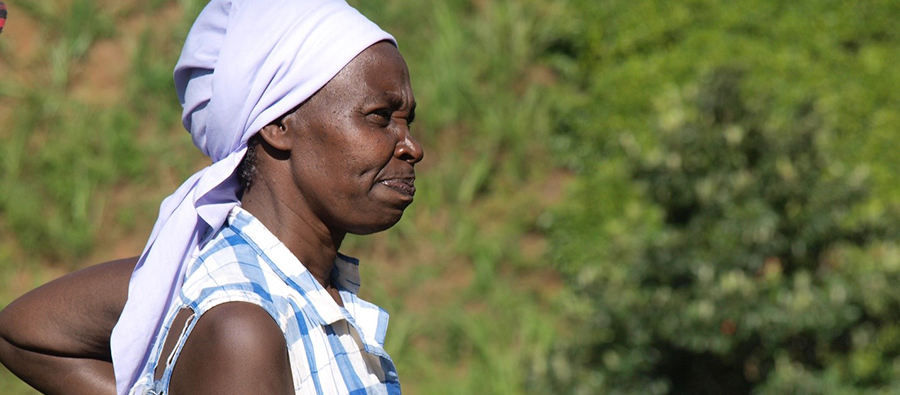With severe weather on the rise, farmers and downstream water users are being besieged by the impacts of erosion. But researchers are finding that the right interventions can cut soil runoff by up to 40% – a benefit that might find its way into struggling farmers’ incomes. Jane Gicheha, a Researcher with The International Center for Tropical Agriculture (CIAT) and CGIAR Research Program on Water, Land and Ecosystems (WLE) explores this topic for Farming First.
With no shoes and little pause, Rachel Njeri bounds down her steep hillside farm, hopping from terrace to terrace until landing at the bottom. A grandmother in her 60s, she can reach the tiny stream 100 meters into the valley of her farm in about two minutes.
At the bottom, Rachel looks up to assess her yields, but also to examine the waves of crumbling land that once sustained crops. Rachel’s farm sits along a steep hillside and erosion is washing her soil downhill, causing small landslides, as well as soil and nutrient loss.
“Look at this maize crop, I will not harvest a thing this season,” laments Rachel. “The soils have been eroded and the remaining are just too acidic for food production. Planting maize and beans results in hunger in my house since most of it will not produce anything.”
Researchers tasked with helping Kenyan farmers stave off erosion cautiously follow her path, arriving minutes after. They examine the damage and results of interventions. “With this kind of loose soil, you need something drastic because whatever you plant is just going to wash away with the next rain.” says CGIAR Research Program on Water, Land and Ecosystems scientist Ravic Nijbroek.

Extreme erosion is eating away at productive farmland and harming water supplies (Jane Gicheha, CIAT)
Erosion is dramatically reducing land productivity in many African countries, especially for smallholders who often work hillside plots. But the challenges are affecting millions downstream too. Erosion increases the rivers’ sediment load – the amount of soil transported downstream into rivers. And with heavy rains and climate unpredictability, the recent loads have been shockingly high.
More than five million Nairobi residents rely on the Tana River for their water use. One Senior Engineer of Kenya’s Ndakaini Dam says, reports that their operating costs are relatively low during the dry season… But during the rainy season, the sediment levels of the rivers rise, leading to siltation of dam, and increasing operating costs.
Researchers show us the evidence
To find the right solutions, it’s critical for researchers to understand how much sediment loads increase during extreme weather events, and during rainy season when farms receive twice the usual amount of rain. And solutions need to work across different farm conditions.
One project addressing these challenges is The Nairobi Water Fund, founded by The Nature Conservancy business, utilities, and governments together with researchers, NGOs and farmers.
The project’s Business Case showed that investing at least US$10 million in on-the-ground environmental management efforts for the Upper Tana River over a decade can reduce sediment concentration in rivers by more than half.
Success could also mean farmers receive payment for ‘ecosystems services’, like protecting water sources for downstream users, such as Coca-Cola and utility companies.
Transforming that vision into reality hinges on providing evidence that shows that the activities being funded upstream are translating to the expected benefits. This is where research is proving vital.
Scientists have been monitoring water at the farm level since May 2015. This means regularly collecting data on water levels, flow, sediment load in rivers, and water turbidity – the level of “dirtiness” in the water.
This data is used to find out whether sustainable land management (SLM) activities such as building terraces, planting trees and installing grass strips are reducing sediment load within the waterbodies.
This data provides a way to prove interventions are making a difference upstream. This is crucial for farmers and for downstream investors who have a stake in the quality of water upstream. In an on-going impact assessment study, which includes interventions on Rachel’s farm, CIAT/WLE researchers have found that the magnitude of runoff and sediment for areas with no SLM were up to 40% higher than in the areas with interventions such as grass strips and terraces. This underpins the importance of trialling a range of interventions on individual farms such as Rachel’s.
With these techniques, the water companies will also find less sediment clogging their equipment, lessening a problem that hikes up treatment and maintenance costs. The benefits and reduced costs can be passed along to Nairobi residents using the water.
Finding the right solutions for sustainable land use
Of course, farmers’ livelihoods are also crucial, along with how benefits flow to women. WLE has provided farmers like Rachel improved fodder seeds for more diverse and productive crops. “I decided to plant Napier grass since it will provide fodder for my livestock and help my soil from being eroded,” says Rachel. “Keeping livestock is also a better investment because I sell milk, and once in a while I sell a cow. I get a lot of money to feed my family and even pay school fees for my grandchildren.”
While evidence shows interventions are helping, Rachel continues to struggle with some erosion. But researchers are working with her and others to better understand how SLM practices can best reduce soil erosion and runoff – on particular farms, and across the watershed. The evidence is paving the way for the best solutions to be scaled up and adapted across the basin – with benefits flowing back to farmers.
So while Rachel continues to bound down her steep hillside to take stock of her crops, the farm’s best soil will hopefully not make that same journey. With the right, well-tested solutions, researchers hope her soil will remain intact, nourishing crops, providing her a comfortable livelihood, and also contributing to the water security of millions of users downstream.

Rachel feeding her livestock (Jane Gicheha, CIAT)



